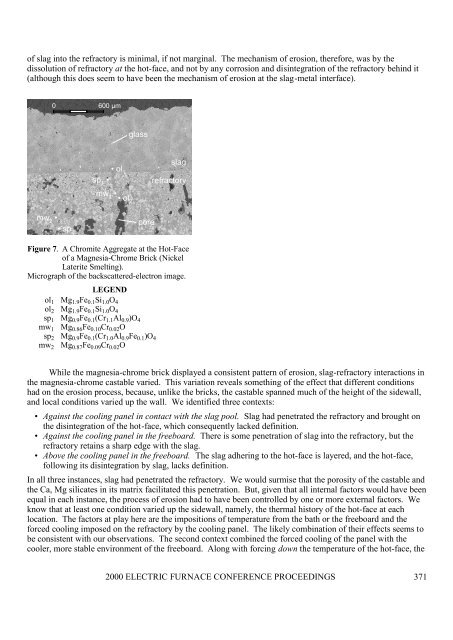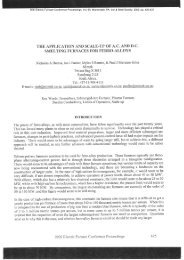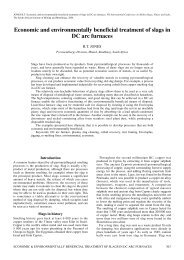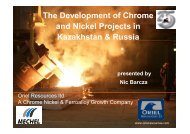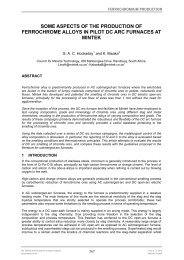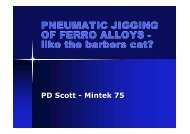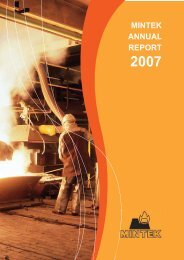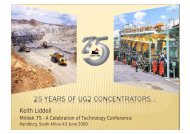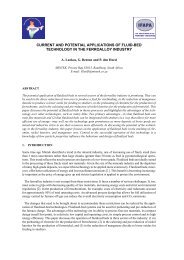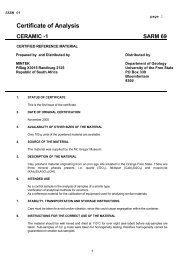Furnace refractory erosion - Mintek
Furnace refractory erosion - Mintek
Furnace refractory erosion - Mintek
You also want an ePaper? Increase the reach of your titles
YUMPU automatically turns print PDFs into web optimized ePapers that Google loves.
of slag into the <strong>refractory</strong> is minimal, if not marginal. The mechanism of <strong>erosion</strong>, therefore, was by thedissolution of <strong>refractory</strong> at the hot-face, and not by any corrosion and disintegration of the <strong>refractory</strong> behind it(although this does seem to have been the mechanism of <strong>erosion</strong> at the slag-metal interface).0 600 µmglass• ol 1sp 1•slag<strong>refractory</strong>mw 1• • ol2mw 2•• sp 2poreFigure 7. A Chromite Aggregate at the Hot-Faceof a Magnesia-Chrome Brick (NickelLaterite Smelting).Micrograph of the backscattered-electron image.LEGENDol 1 Mg 1.9 Fe 0.1 Si 1.0 O 4ol 2 Mg 1.9 Fe 0.1 Si 1.0 O 4sp 1 Mg 0.9 Fe 0.1 (Cr 1.1 Al 0.9 )O 4mw 1 Mg 0.86 Fe 0.10 Cr 0.02 Osp 2 Mg 0.9 Fe 0.1 (Cr 1.0 Al 0.9 Fe 0.1 )O 4mw 2 Mg 0.87 Fe 0.09 Cr 0.02 OWhile the magnesia-chrome brick displayed a consistent pattern of <strong>erosion</strong>, slag-<strong>refractory</strong> interactions inthe magnesia-chrome castable varied. This variation reveals something of the effect that different conditionshad on the <strong>erosion</strong> process, because, unlike the bricks, the castable spanned much of the height of the sidewall,and local conditions varied up the wall. We identified three contexts:• Against the cooling panel in contact with the slag pool. Slag had penetrated the <strong>refractory</strong> and brought onthe disintegration of the hot-face, which consequently lacked definition.• Against the cooling panel in the freeboard. There is some penetration of slag into the <strong>refractory</strong>, but the<strong>refractory</strong> retains a sharp edge with the slag.• Above the cooling panel in the freeboard. The slag adhering to the hot-face is layered, and the hot-face,following its disintegration by slag, lacks definition.In all three instances, slag had penetrated the <strong>refractory</strong>. We would surmise that the porosity of the castable andthe Ca, Mg silicates in its matrix facilitated this penetration. But, given that all internal factors would have beenequal in each instance, the process of <strong>erosion</strong> had to have been controlled by one or more external factors. Weknow that at least one condition varied up the sidewall, namely, the thermal history of the hot-face at eachlocation. The factors at play here are the impositions of temperature from the bath or the freeboard and theforced cooling imposed on the <strong>refractory</strong> by the cooling panel. The likely combination of their effects seems tobe consistent with our observations. The second context combined the forced cooling of the panel with thecooler, more stable environment of the freeboard. Along with forcing down the temperature of the hot-face, the2000 ELECTRIC FURNACE CONFERENCE PROCEEDINGS 371


